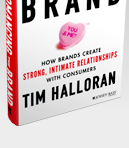A PEEK INSIDE - SAMPLE CHAPTERS
Chapter One
IT’S NOT JUST FOR THE TASTE OF IT
I had already been in the dark room for 3 ½ hours, a bowl of peanut M&Ms in front of me, observing various women explaining their beverage consumptions habits through a two way mirror (that felt like something out of CSI). Observing focus groups was a common practice for Coca-Cola brand managers. We were always striving to understand our consumers better so that we might find a way to connect with them. You see, our ultimate goal was to give folks like the ladies in this room a reason that they would purchase our brand vs. the hundreds of other options available to them in consuming the required 64 ounces of daily liquid that their bodies physically needed to survive.
But as I was observing yet focus another group, I was thinking to myself, “How much of what I did on a daily basis at the world’s largest soft drink company, trying to meet the needs of a finicky consumer base with some creative new message or compelling product improvement was complete and utter nonsense?” Did consumers really care about these brands? Was I just doing my part in creating an illusion that was built on little substance? Looking around the observation room, I saw 6 or 7 colleagues in various stages of engagement – the assistant brand manager taking copious notes that would ultimately summarize our findings to our senior management, the agency account rep trying to show off and infer something brilliant from something that was said, and the marketing research manager looking at the research guide to ensure that the moderator on the other side of the glass was covering everything on our checklist. All waiting, observing, listening for anything that we could use in developing next year’s marketing campaign.
But then one of those "a-ha" moments occurred. It crystallized, at least to me, exactly what we needed to be doing and specifically how we needed to think about marketing our brands to consumers. It wasn’t terribly grandiose and, on the surface, seemed more like “just another crazy focus group moment” that we were so used to in our line of work. Most folks in the room would think nothing of it beyond it being yet another story to put in their array of focus group anecdotes, but for me it completely changed my perception about how we as marketers should think about brands and the role that they play in our consumers’ lives. In short, it radically altered my perspective on how marketers should engage with consumers.
The eight women sat around the overflowing table of colored cans and bottles that represented the various brands of soft drinks. They had just completed what we term a “sorting” exercise in which the women group soft drink brands in groups based on some organizing principle that they were to develop. I don’t remember how they organized the 40+ brands that day, but what happened next stuck with me. Susan, a petite woman in her late 20s, picked up one of the cans and said to the focus group moderator, “I drink 8 of these a day. It is always with me, no matter what happens. It was there when my boss gave me my promotion last week. It was at my side two months ago when my cat died. It got me through it. I start and end my day with it. It’s never lets me down. I can always count on it. To sum it up, it’s my boyfriend…Diet Coke."
A wave of laughter hit the backroom that I’m sure could be heard by the respondents on the other side of the 2-way mirror. Did she really say that Diet Coke acted so strongly as a support function that she viewed it as boyfriend? How can one think of a can of sugar water (actually aspartame water in this case) in boyfriend terms? How can an inanimate soft drink act as a support mechanism when loss occurs? How can it be a celebratory friend when we get good news? Preposterous. We can’t connect with products the same way we connect with people!
But that is exactly what we do. Academic study after academic study has proven it. We don’t just consume or interact with brands on a monthly, daily, or even hourly basis. We actually engage in relationships with them. Life is a series of relationships. Relationships with people, relationships with beliefs, and yes, even relationships with brands. With some brands, we have wild, short term flings. Others stay with us for a lifetime, like family. Some brands offer us strictly utilitarian relationships — they are in our daily lives, yet we have no emotional connection to them. Is your relationship with a particular brand intimate, or is it more casual, like that of your local grocer? Maybe the brand feels like good medicine, like a physician, or maybe it’s a loose connection, like a distant uncle. Or maybe you rely on it, like a teacher, a coach, or even a parent. Each product and each consumer is different. But as I started looking at it more closely, it was abundantly clear that we as consumers engage in relationships with brands. If marketers were going to succeed, they would need to go beyond thinking about consumers as “target markets” who they needed to make aware of, try, and purchase their brand again. They needed to think about engaging consumers in a long term relationship.
Think about it from your perspective as an everyday consumer. Think about a brand that means something, really means something to you. Maybe there is a certain brand of clothing that you seek out first in a store. What about a certain pair of shoes that you must have? Perhaps you are willing to drive an extra 2 miles down the road past your local grocery store to the Trader Joe’s because of what they offer. Maybe when you order a Coke and the waiter asks if Pepsi is ok, you say that it’s not. Maybe when planning a business trip, you instinctively check to see if your preferred hotel has a location in the market you are visiting. Think back to your childhood. Was there a video game system or Lego set or doll that you absolutely had to have? When you were a teenager, was there a musical act that you waited with anticipation for their new album, ran to the record store (remember those?) to pick it up the day it was released? All of these are examples of brands – products, retailers, or even people that make up the fabric of our everyday lives. Sure they provide you with some recognizable functional benefits – the look and feel of a Polo shirt, the variety of organic lines in Whole Foods, or the beat and melody of the latest Maroon 5 song - but I would argue they provide you much more. Maybe you feel that it says something about you to others when you are consuming, wearing, or using it. Or maybe you feel that the brand has a personality that you can relate to. Perhaps a brand not only occupies a specific place in your mind, but also occupies a specific place in your heart or, dare I say, your soul.
Now, think about the first time you encountered that brand. Do you have a distinct memory of it? Was it “love at first sight” or did it take awhile for you to adopt it? Has your relationship with that brand grown over time? Is it as strong today as it has ever been or did it reach its peak some time ago and has now plateaued or even declined? Now, think about if that brand suddenly disappeared. It was gone from the face of the earth. How does your life change? How do you feel? What do you go through? Can something easily replace it or does it result in a hole in your life in some way, shape or form? Chances are that there are certain brands in which you’ve developed such a strong connection and have engaged with so frequently that if something were to happen, such as if they were discontinued or changed, that you would feel a sense of loss or betrayal.
Think about how those Harley Davidson fans who feel so strongly about the brand that they will get its logo tattooed on a vital body part. What is it about the new Apple I-Pad or I-Phone or I-Anything that will make people sleep outside in frigid temperatures on a concrete sidewalk outside a Best Buy to be one of the first to purchase it? Why is it that families will plunk down an entire life savings to spend a week at Disney World and, despite the Florida summer heat and humidity, will claim that it was the absolute best vacation they have ever had? The answer is that these and many brands have successfully created and cultivated a relationship with their consumer target. But how have they done it? And why does it matter today more than ever? Technology today has given us a plethora of new tools that we don’t fully understand or know how to use – primarily because we are trying to apply them within the context of an outdated way of thinking. Marketing is changing and changing fast. If we don’t think about marketing our brands in a completely different way - a way that is fundamentally based in the brand’s relationship with the consumer, then we will never achieve success. My goal in this book is to get you thinking in a radically new way about how to connect with the consumer and it starts by creating a relationship.
Download full chapter (PDF format)
|
|
|
 |
“Whether you are starting a new business or working on an established brand, Romancing the Brand reveals many critical steps for success. Tim Halloran explores the valued secrets to engaging in an ongoing, compassionate relationship with your consumer. Great read, great insight, great book!”
—Daymond John, founder, president, and CEO, FUBU, and costar, ABC series Shark Tank
“We live in an era of huge changes in marketing and consumer behavior, but Romancing the Brand is a reminder that passion is timeless. Brands can be successful in the long run by cultivating deep, lasting relationships with customers.”
—Steve Koonin, president, Turner Entertainment Networks
See more Accolades
ORDER NOW
      CONNECT WITH US
CONNECT WITH US
  |
|
 |
|

